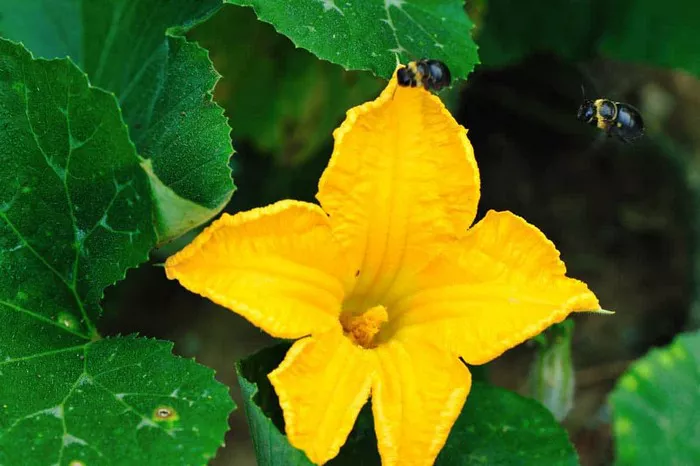Pumpkins are not only beloved for their delicious flesh but also for the beauty of their flowers. These vibrant blooms not only add aesthetic appeal to the pumpkin plant but also serve a crucial role in its reproduction. In this comprehensive guide, we’ll delve into the intricate details of pumpkin flowers, exploring their appearance, structure, and significance in the life cycle of this iconic gourd.
Appearance
Pumpkin flowers, also known as pumpkin blossoms, exhibit a striking appearance that catches the eye of any observer. They typically grow on long, sprawling vines that emerge from the main stem of the pumpkin plant. These vines produce both male and female flowers, each with its distinct characteristics.
Male pumpkin flowers are often the first to appear, distinguished by their slender stems and bright yellow petals. These petals form a star-like shape, surrounding a prominent stamen in the center. The stamen consists of a filament topped with an anther, where pollen is produced. Male flowers typically outnumber female flowers and play a crucial role in pollination.
Female pumpkin flowers, on the other hand, develop slightly later than their male counterparts. They can be identified by their shorter stems and the presence of a small, bulbous ovary at the base of the flower. The ovary eventually develops into the fruit, housing the seeds of the pumpkin. Female flowers feature a stigma, which is sticky and receptive to pollen, facilitating fertilization.
Both male and female pumpkin flowers are ephemeral, blooming for only a short period before withering away. However, during their brief lifespan, they add a burst of color and charm to the pumpkin patch, attracting pollinators such as bees, butterflies, and even some species of birds.
Structure
The structure of pumpkin flowers is intricately designed to facilitate successful pollination and reproduction. Understanding the anatomy of these flowers provides insights into their function within the plant’s life cycle.
At the center of the pumpkin flower lies the reproductive organs essential for fertilization. In male flowers, the stamen consists of a slender filament supporting an anther, where pollen grains are produced. When mature, the anther releases pollen, which is then dispersed by wind or carried by pollinators to female flowers.
Female flowers feature a stigma, which is located at the center of the flower and surrounded by several lobes. The stigma is covered in a sticky substance that captures pollen grains. Beneath the stigma lies the style, a tube-like structure connecting the stigma to the ovary. Once pollen grains adhere to the stigma, they germinate and send pollen tubes through the style to reach the ovary, where fertilization occurs.
The ovary of the female flower houses the ovules, which upon fertilization develop into seeds. As the ovary matures, it swells to form the familiar round shape of the pumpkin fruit. The development of the fruit is triggered by successful fertilization, ensuring the propagation of the pumpkin plant.
Significance in the Life Cycle
Pumpkin flowers play a vital role in the reproductive cycle of the pumpkin plant, ensuring the production of seeds for future generations. The process of pollination, facilitated by these flowers, is essential for fruit development and ultimately, seed dispersal.
Pollination begins when pollen grains are transferred from the anthers of male flowers to the stigma of female flowers. This transfer can occur through various mechanisms, including wind, insects, or other pollinators. Once on the stigma, pollen grains germinate, forming pollen tubes that deliver male gametes to the ovules within the ovary.
Fertilization occurs when male gametes fuse with female gametes within the ovules, initiating seed development. As the seeds mature, the ovary of the female flower transforms into the fleshy fruit we recognize as a pumpkin. The fruit provides protection and nourishment to the seeds until they are ready for dispersal.
Upon reaching maturity, the pumpkin fruit undergoes senescence, signaling the end of the plant’s reproductive cycle. However, the seeds contained within the fruit remain viable, capable of germinating to produce new pumpkin plants under favorable conditions. Thus, the cycle continues, ensuring the survival and proliferation of the pumpkin species.
In addition to their reproductive function, pumpkin flowers also contribute to the ecosystem by attracting pollinators. Bees, in particular, are frequent visitors to pumpkin flowers, collecting nectar and inadvertently transferring pollen between flowers as they forage. This mutualistic relationship benefits both the pumpkin plant and the pollinators, ensuring the continued success of both parties.
Conclusion
Pumpkin flowers are not merely decorative adornments but integral components of the plant’s reproductive system. Their vibrant blooms and intricate structures serve to attract pollinators and facilitate the transfer of pollen, ultimately leading to the production of seeds and the continuation of the pumpkin species. Understanding the appearance, structure, and significance of pumpkin flowers provides valuable insights into the fascinating world of plant reproduction and the interconnectedness of organisms within ecosystems. So, the next time you admire a pumpkin vine in full bloom, take a moment to appreciate the beauty and complexity of its flowers, knowing that they are the harbingers of future harvests and the guardians of biodiversity.


